Sumerian Pottery Technology Studied Through Neutron Diffraction and Chemometrics at Abu Tbeirah (Iraq)
Abstract
1. Introduction
Archaeological and Geological Background
2. Materials and Methods
2.1. Description of the Samples
- Fabric A: fine-grained paste with low porosity featured by planar voids. Red-orange paste colour. Firing mainly in an oxidising atmosphere. Self-slipped or sometimes covered with clearer slip (fabric A + slip)—samples n. 2, 3, 6–9, 12, 14, 15, 17–19, 23, 31, 32, 34.
- Fabric B1: fine-grained paste with a low porosity featured by planar voids. Yellow paste colour. Firing mainly in an oxidising atmosphere. Sometimes self-slipped—samples n. 5, 10, 20, 27, 35, 36.
- Fabric B2: fine-grained paste with a low porosity featured by planar voids. Yellow paste colour with orange inclusions. Firing mainly in an oxidising atmosphere—samples n. 1, 13, 21, 24–26, 28.
- Fabric C: coarse-grained paste with abundant sedimentary fragments and angular inclusions. High porosity compared to other groups. Firing mainly in an oxidising atmosphere-sample n. 33.
- Fabric D1: fine-grained paste with abundant straw. Red-orange paste colour. Firing mainly in an oxidising atmosphere-sample n. 30.
- Fabric D2: fine-grained paste with abundant straw. Yellow paste colour with orange inclusions. Firing mainly in an oxidising atmosphere-samples n. 4, 11, 22, 29.
2.2. Association between Fabrics and Pottery Shapes at Abu Tbeirah
2.3. Experimental Set-Up
3. Results
4. Conclusions
Author Contributions
Acknowledgments
Conflicts of Interest
References
- Rice, P.M. Pottery Analysis: A Sourcebook. The Raw Materials of Pottery Making: Perspectives from Chemistry, Geology, and Engineering; University of Chicago Press: Chicago, IL, USA, 2015. [Google Scholar]
- Bland, C.; Roberts, A.L.; Popelka-Filcoff, R.S.; Santoro, C.M. Early vitrification stages identified in prehistoric earthenware ceramics from northern Chile via SEM. J. Archaeol. Sci. Rep. 2017, 16, 309–315. [Google Scholar] [CrossRef]
- Cardiano, P.; Ioppolo, S.; De Stefano, C.; Pettignano, A.; Sergi, S.; Piraino, P. Study and characterization of the ancient bricks of monastery of “San Filippo di Fragalà” in Frazzanò (Sicily). Anal. Chim. Acta 2004, 519, 103–111. [Google Scholar] [CrossRef]
- De Bonis, A.; Cultrone, G.; Grifa, C.; Langella, A.; Leone, A.P.; Mercurio, M.; Morra, V. Different shades of red: The complexity of mineralogical and physico-chemical factors influencing the colour of ceramics. Ceram. Int. 2017, 43, 8065–8074. [Google Scholar] [CrossRef]
- De Benedetto, G.E.; Laviano, R.; Sabbatini, L.; Zambonin, P.G. Infrared spectroscopy in the mineralogical characterization of ancient pottery. J. Cult. Herit. 2002, 3, 177–186. [Google Scholar] [CrossRef]
- El Ouahabi, M.; Daoudi, L.; Hatert, F.; Fagel, N. Modified Mineral Phases During Clay Ceramic Firing. Clays Clay Miner. 2015, 63, 404–413. [Google Scholar] [CrossRef]
- Moorey, P.R.S. Ancient Mesopotamian Materials and Industries: The Archaeological Evidence; Eisenbrauns: Warsaw, IN, USA, 1994; p. 144. [Google Scholar]
- Armstrong, J.A.; Gasche, H. Mesopotamian Pottery. A Guide to the Babylonian Tradition in the Second Millennium B.C; The University of Ghent: Ghent, Belgium; The Oriental Institute of the University of Chicago: Chicago, IL, USA, 2014; p. 83. [Google Scholar]
- Smith, A.L. Bonfire II: The Return of Pottery Firing Temperatures. J. Archaeol. Sci. 2008, 28, 991–1003. [Google Scholar] [CrossRef]
- Squires, G.L. Introduction to the Theory of Thermal Neutron Scattering; Cambridge University Press: Cambridge, MA, USA, 1978. [Google Scholar]
- Bland, C.; Roberts, A.L.; Popelka-Filcoff, R.; Santoro, C.; Carter, C.; Bennett, J.; Stopic, A. 1500 years of pottery: Neutron activation analysis of northern Chilean domestic ceramics from Caleta Vitor and clay samples from nearby valley and highland contexts. Archaeometry 2017, 59, 815–833. [Google Scholar] [CrossRef]
- D’Agostino, F.; Romano, L. Rediscovering Sumer. Excavations at Abu Tbeirah. Southern Iraq. In My Life Is Like the Summer Rose; Cerasetti, B., Lamberg-Karlovsky, C.C., Eds.; Maurizio Tosi e l’Archeologia Come Modo di Vivere. Papers in Honour of Maurizio Tosi for His 70th Birthday; BAR-IS 2690; Archaeopress: Oxford, UK, 2014; pp. 163–167. [Google Scholar]
- D’Agostino, F.; Kadhem, A.; Romano, L.; Vidale, M.; Angelozzi, M. Abu Tbeirah. Preliminary Report of the First Campaign (January–March 2012). Rivista Degli Studi Orientali 2011, 84, 17–34. [Google Scholar]
- D’Agostino, F.; Romano, L. Abu Tbeirah. Preliminary Report of the 2012–2013 Campaigns. In Proceedings of the 9th International Congress on the Archaeology of the Ancient Near East, Basel, Switzerland, 9–13 June 2014; Kaelin, R.S.O., Mathys, H.-P., Eds.; Harrassowitz: Wiesbaden, Germany, 2014. [Google Scholar]
- D’Agostino, F.; Romano, L.; Khadem, A.; Tafuri, M.A. Abu Tbeirah. Preliminary Report of the Second Campaign (October–December 2012). Rivista Degli Studi Orientali 2013, 86, 69–92. [Google Scholar]
- D’Agostino, F. Rediscovering and Revitalizing the History of Iraq: The Excavations at Abu Tbeirah. In Strategie e Programmazione della Conservazione e Trasmissibilità del Patrimonio Culturale; Filipovic, A., Troiano, W., Eds.; Italian Heritage Awards; Edizioni Scientifiche Fidei Signa: Roma, Italy, 2013; pp. 212–221. [Google Scholar]
- D’Agostino, F.; Romano, L.; Kadhem Ghanim, A. Abu Tbeirah. Nasiriyah (Southern Iraq). Preliminary Report on the 2013 Excavation Campaign. Available online: https://revistas.uam.es/isimu/article/view/3209 (accessed on 29 January 2019).
- Nardini, M.; Andreani, C.; Senesi, R.; Scherillo, A.; D’Agostino, F.; Romano, L.; Scatigno, C.; Festa, G. Neutron Resonance Capture Analysis and chemometric tools: An integrated approach. J. Phys. Conf. Ser. 2018, 1055, 012005. [Google Scholar] [CrossRef]
- Postma, H.; Schillebeeckx, P. Non-destructive analysis of objects using neutron resonance capture. J. Radioanal. Nucl. Chem. 2005, 265, 297–302. [Google Scholar] [CrossRef]
- Thuesen, I.; Heydorn, K.; Gwozdz, R. Investigation of 5000-Year-Old Pottery from Mesopotamia by Instrumental Neutron Activation Analysis. In Proceedings of the Second Nordic Conference on the Application of Scientific Methods in Archaeology, Helsingør, Denmark, 17 August–19 August 1981; Mejdahl, V., Ed.; Council of Europe: Strasbourg, France, 1982; Volume 2, pp. 375–381. [Google Scholar]
- Mynors, H.S. An Examination of Mesopotamian Ceramics Using Petrographic and Neutron Activation Analysis. In Proceedings of the 22nd Symposium on Archaeometry Held at the University of Bradford, Bradford, UK, 30 March–3 April 1982; Aspinall, A., Warren, S., Eds.; University of Bradford: Bradford, UK, 1983; pp. 377–387. [Google Scholar]
- Mynors, H.S.; Al Kaissi, B. Ceramic Analyses of Mesopotamian Wares in the Early Dynastic Period. In Research on the Antiquities of Saddam Dam Basin Salvage and Other Researches; Republic of Iraq, Ministry of Culture and Information, State Organization of Antiquites and Heritage: Baghdad, Iraq, 1987; pp. 134–154. [Google Scholar]
- Méry, S.; Schneider, G. Mesopotamian Pottery Wares in Eastern Arabia from the 5th to the 2nd Millennium BC: A Contribution of Archaeometry to the Economic History. In Proceedings of the Twenty-Ninth Meeting of the Seminar for Arabian Studies, Cambridge, UK, 20–22 July 1995; Archaeopress Publishing Ltd.: Oxford, UK, 1996; Volume 26, pp. 79–96. [Google Scholar]
- McGibson, G. Uch Tepe II: Technical Reports; The Oriental Institute of the University of Chicago: Chicago, IL, USA, 1990. [Google Scholar]
- Sanjurjo-Sánchez, J.; Montero Fenollós, J.L.; Polymeris, G.S. Technological aspects of Mesopotamian Uruk pottery: Estimating firing temperatures using mineralogical methods, thermal analysis and luminescence techniques. Archaeol. Anthropol. Sci. 2018, 10, 849–864. [Google Scholar] [CrossRef]
- Verhoeven, K. Geomorphological Research in the Mesopotamian Flood Plain. In Changing Watercourses in Babylonia. Towards a Reconstruction of the Ancient Environment in Lower Mesopotamia; Gasche, H., Tanret, M., Eds.; Volume I. Mesopotamian History and Environment. Series II. Memoirs V; The University of Ghent: Gent, Belgium, 1998; pp. 159–240. [Google Scholar]
- Yacoub, S.Y. Stratigraphy of the Mesopotamia Plain. Iraqi Bull. Geol. Min. 2011, 4, 47–82. [Google Scholar]
- Al-Asadi, M.M.M. The Sedimentary Model of Thi-Qar Governorate During the Holocene. South West Iraq. J Basrah Res. (Sci.) 2007, 33, 91–101. [Google Scholar]
- Sissakian, V.K.; Saeed, Z.B. Lithological Map of Iraq. Compiled Using GIS Techniques. Iraqi Bull. Geol. Min. 2012, 8, 1–13. [Google Scholar]
- Alfatlawi, E.A.M. Swelling Potential and Mineralogy of Thi-Qar University Soil. J. Thi-Qar Univ. 2011, 7, 1–15. [Google Scholar]
- Al-Mukhtar, L.E. Heavy Mineral Analysis of the Quaternary Sediments in the Southern Part of the Mesopotamia Plain, Iraq. Iraqi Bull. Geol. Min. 2015, 11, 59–73. [Google Scholar]
- Ali, M.Y.; Watts, A.B.; Searle, M.P. Seismic stratigraphy and subsidence history of the United Arab Emirates (UAE) rifted margin and overlying foreland basins. In Lithosphere Dynamics and Sedimentary Basins: The Arabian Plate and Analogues; Springer: Berlin/Heidelberg, Germany, 2013; pp. 127–143. [Google Scholar]
- Erb-Satullo, N.L. Alloys from Anau: The Manipulation of Metallic Properties in 3rd Millennium B.C. Southern Central Asia. MRS Proc. 2011, 1319. [Google Scholar] [CrossRef]
- Courty, M.A.; Roux, V. Identification of Wheel-Throwing on the Basis of Ceramic Surface Features and Microfabrics. J. Archaeol. Sci. 1995, 22, 17–50. [Google Scholar] [CrossRef]
- Courty, M.A.; Roux, V. Identification of Wheel-Fashioning Methods: Technological Analysis of 4th-3rd Millennium BC Oriental Ceramics. J. Archaeol. Sci. 1998, 25, 747–763. [Google Scholar]
- Romano, L. A Fragment of a Potter’s Wheel from Abu Tbeirah. Zeitschrift für Assyriologie 2015, 105, 220–234. [Google Scholar] [CrossRef]
- Roux, V.; Rosen, S. An Introduction to Technological Studies in the Archaeology of the Proto-Historic and Early Historic Periods in the Southern Levant. In Techniques and People: Anthropological Perspectives on Technology in the Archaeology of the Proto-Historic and Early Historic Periods in the Southern Levant; Rosen, S., Roux, V., Eds.; De Boccard: Paris, France, 2009; pp. 11–22. [Google Scholar]
- Imberti, S.; Kockelmann, W.; Celli, M.; Grazzi, F.; Zoppi, M.; Botti, A. Neutron diffractometer INES for quantitative phase analysis of archaeological objects. Meas. Sci. Technol. 2008, 19, 034003. [Google Scholar] [CrossRef]
- Windsor, C.G. Pulsed Neutron Scattering; Taylor and Francis: London, UK, 1981. [Google Scholar]
- Larson, A.C.; von Dreele, R.B. GSAS: General Structure Analysis System; Report LAUR 86-748; Los Alamos Laboratory: Los Alamos, NM, USA, 1986. [Google Scholar]
- Toby, B.H. EXPGUI, a graphical user interface for GSAS. J. Appl. Cryst. 2001, 34, 210–213. [Google Scholar] [CrossRef]
- Jolliffe, I.T. Principal Component Analysis; Springer: Berlin, Germany, 1986; p. 487. ISBN 978-0-387-95442-4. [Google Scholar]
- Husson, F.; Lê, S.; Pagès, J. Exploratory Multivariate Analysis by Example Using R; The R Series; Chapman & Hall/CRC: London, UK, 2009; 224p, ISBN 978-2-7535-0938-2. [Google Scholar]
- Baxter, M.J. Exploratory Multivariate Analysis in Archaeology; Edinburgh University Press: Edinburgh, UK, 1994. [Google Scholar]
- Available online: https://www.camo.com/unscrambler/ (accessed on 29 January 2019).
- Arai, K.; Barakbah, A.R. Hierarchical K-means: An algorithm for centroids initialization for K-means. Rep. Fac. Sci. Eng. 2007, 36, 25–31. [Google Scholar]
- Anderberg, M.R. Cluster Analysis for Applications, 1st ed.; No. OAS-TR-73-9; Elsevier: New York, NY, USA, 1973. [Google Scholar]
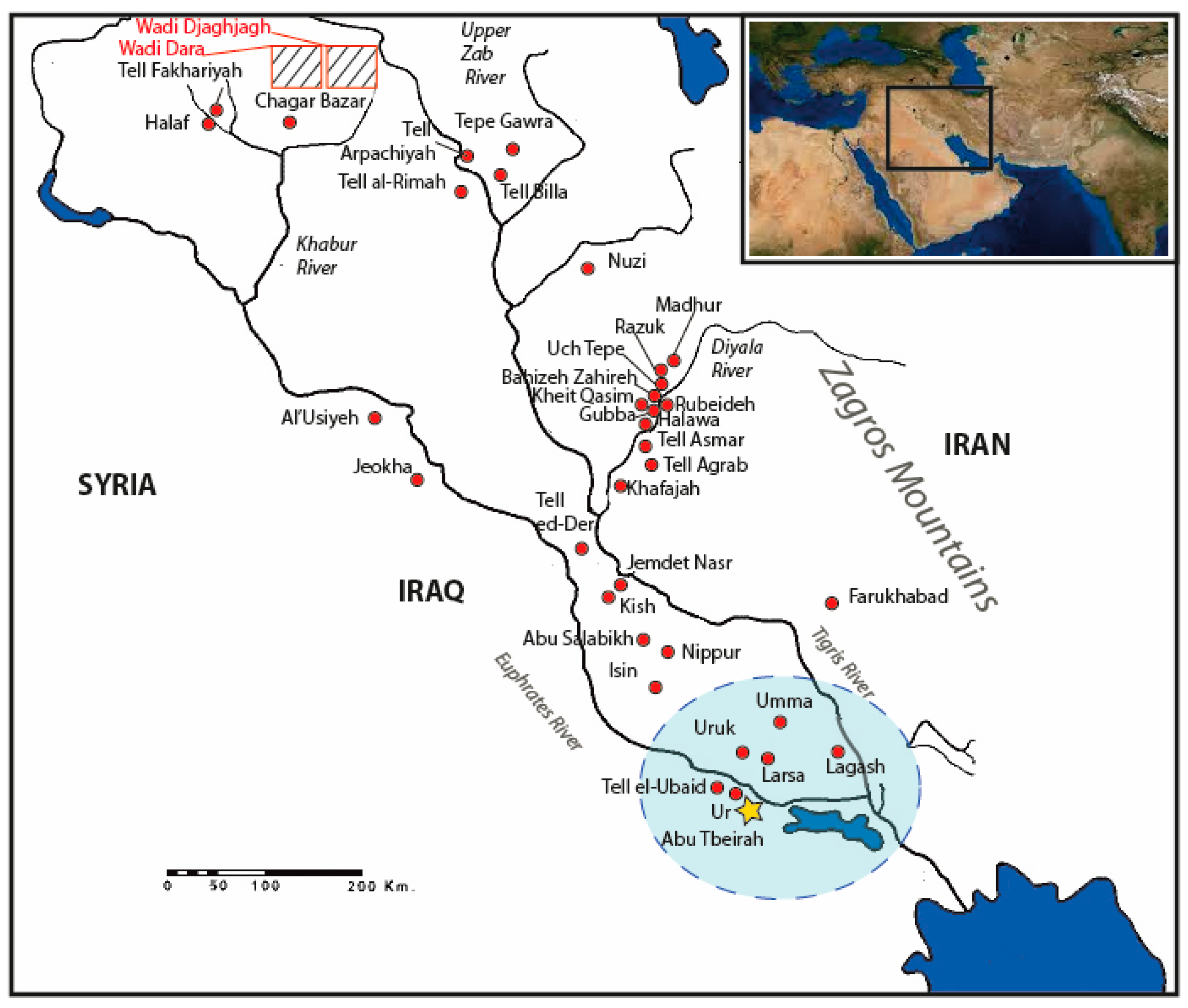
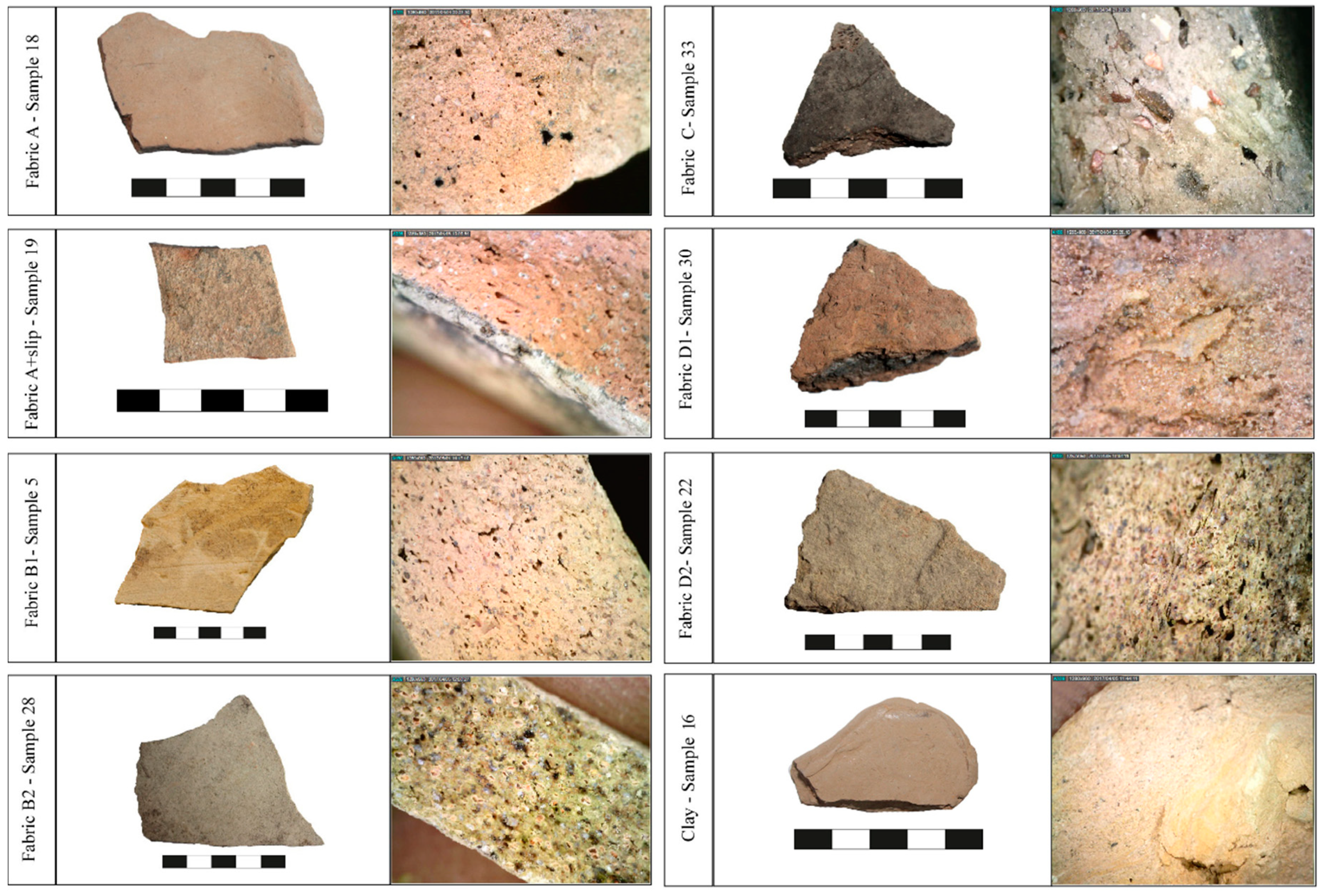
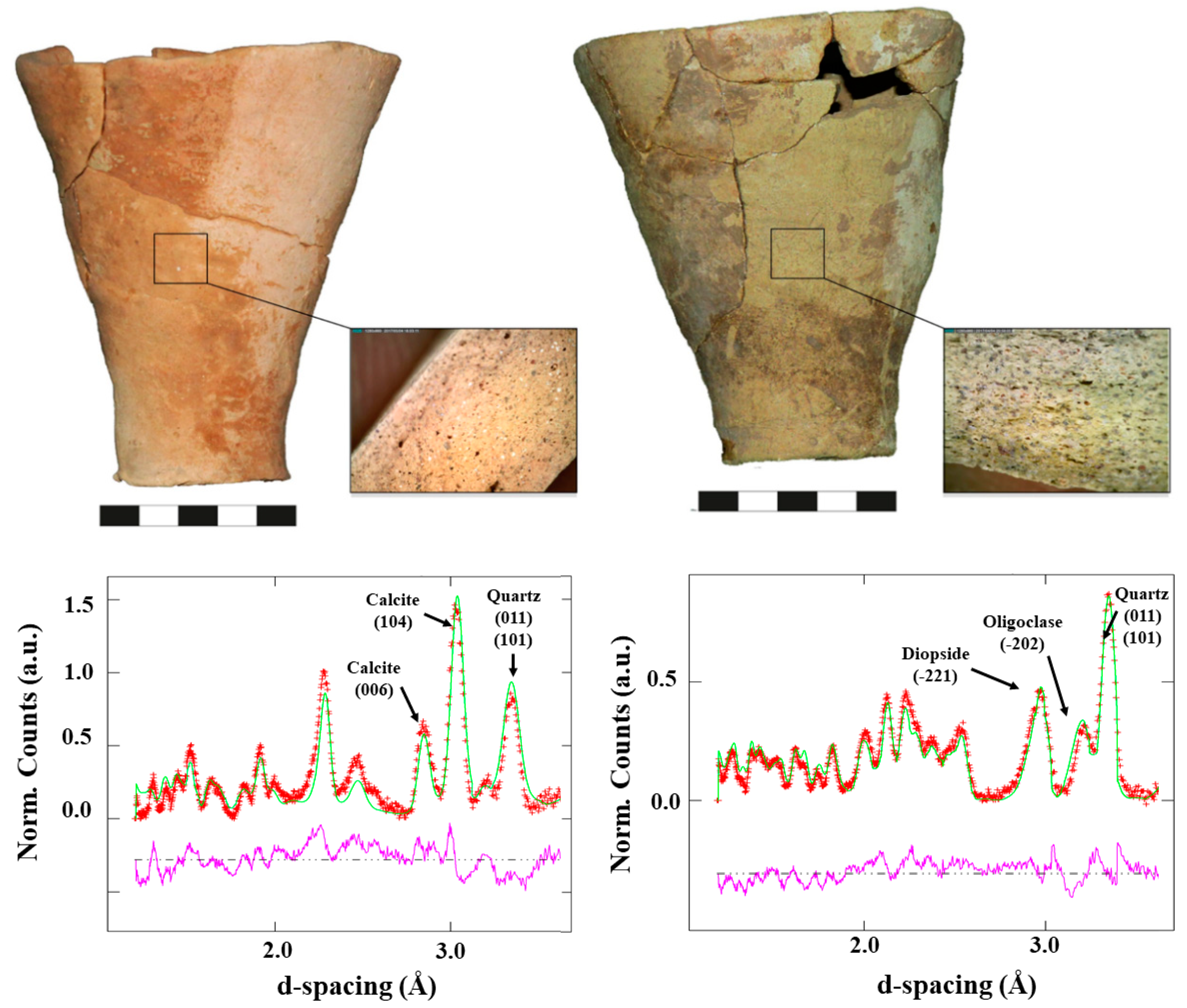

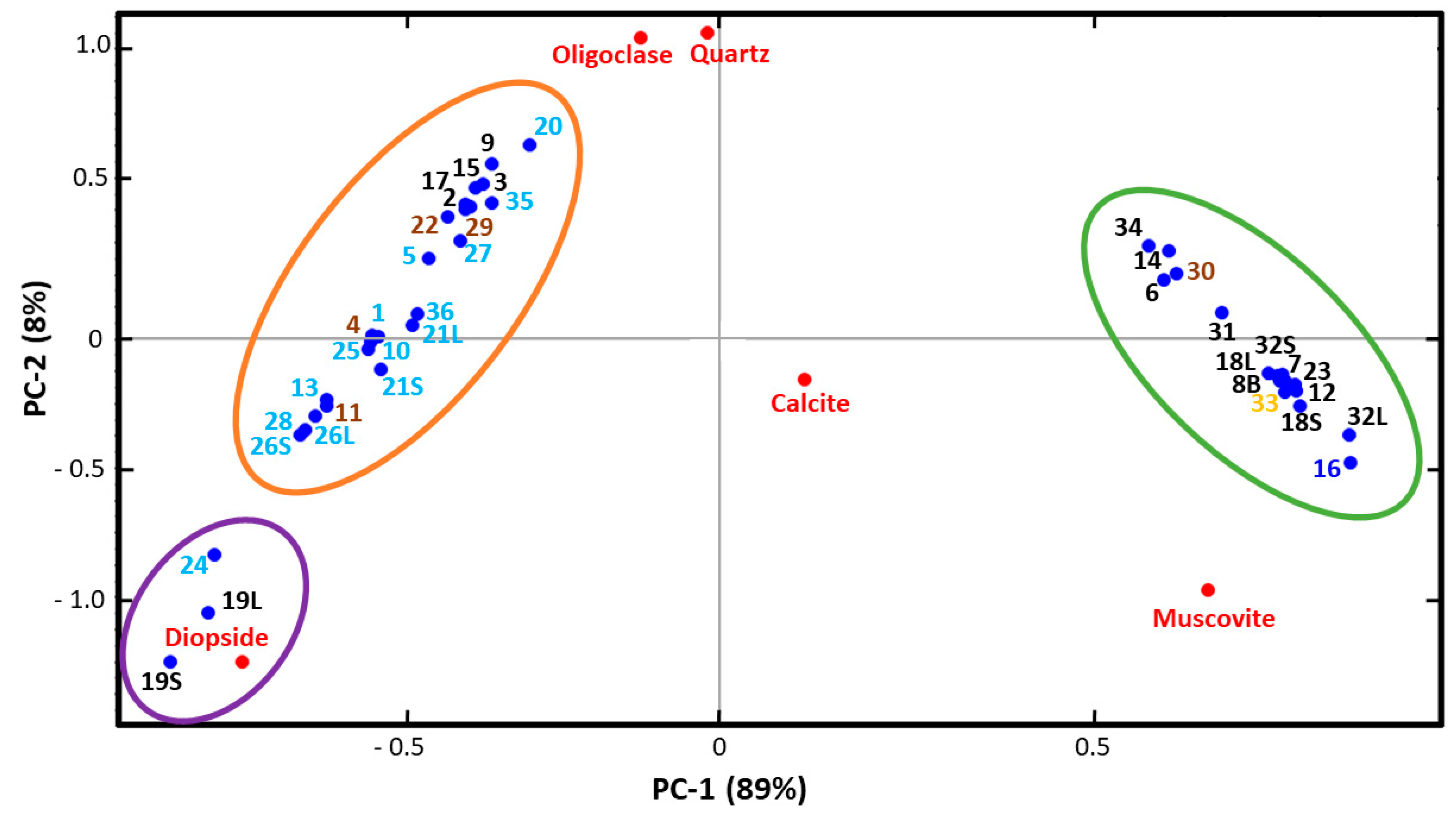
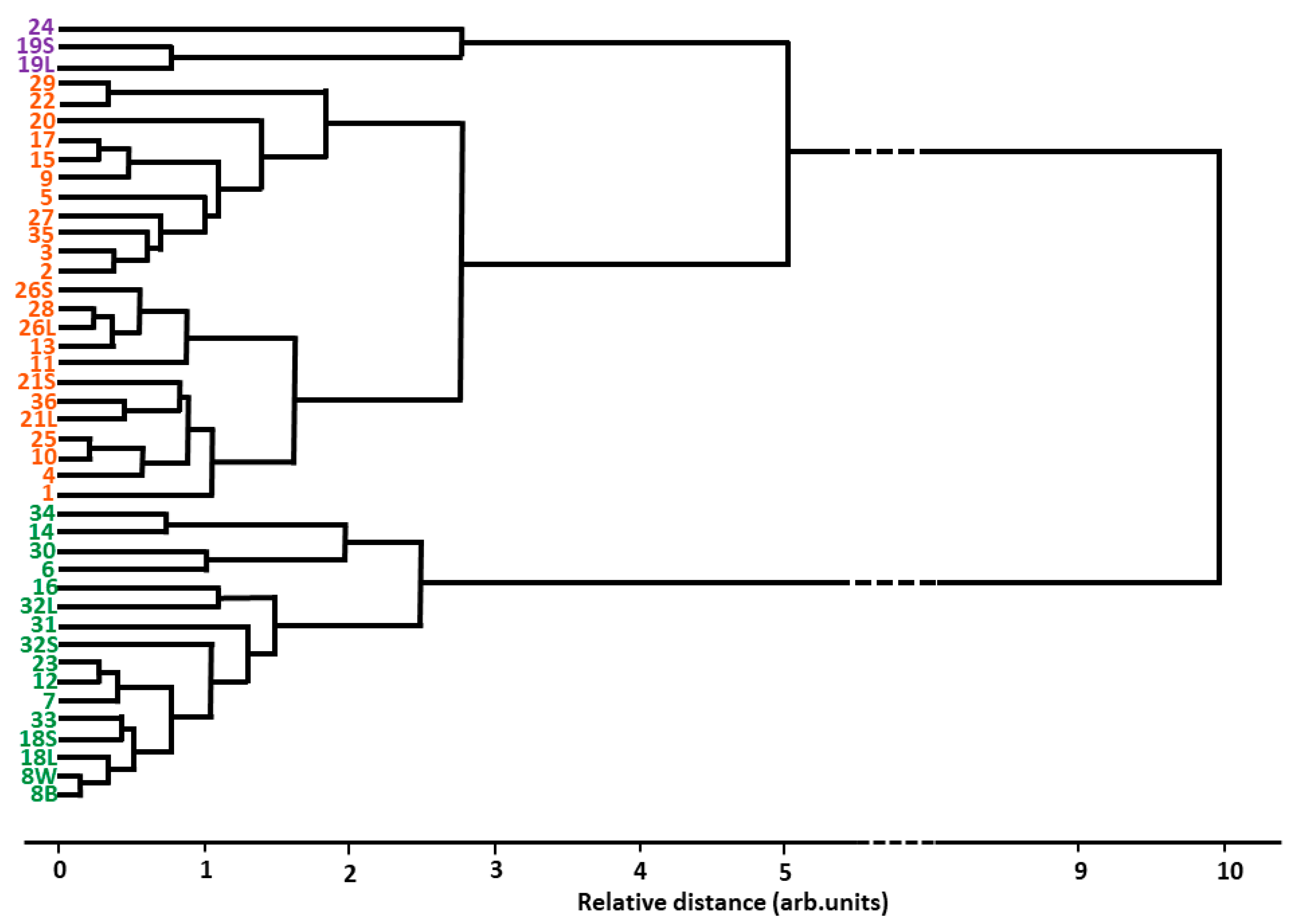
| Sample | Fabric | Thickness (cm) | Calcite | Quartz | (Pyroxenes) Diopside | (Feldspar) Oligoclase | (Phyllosilicate/mica) Muscovite |
|---|---|---|---|---|---|---|---|
| 1 | B2 | 0.6 | - | 15.7 | 50.5 | 33.8 | - |
| 2 | A | 0.7 | - | 29.1 | 38.9 | 32.0 | - |
| 3 | A | 0.9 | - | 29.8 | 36.5 | 33.7 | - |
| 4 | D2 | 1.9 | - | 18.9 | 51.1 | 30.0 | - |
| 5 | B1 | 0.7 | - | 23.8 | 43.4 | 32.8 | - |
| 6 | A | 0.6 | 17.9 | 22.4 | - | 19.5 | 40.2 |
| 7 | A | 0.8 | 8.3 | 12.4 | - | 22.6 | 56.7 |
| 8B* | A | 0.6 | 11.1 | 15.2 | - | 18.7 | 55.0 |
| 8W* | A | 0.6 | 10.5 | 15.7 | - | 19.0 | 54.8 |
| 9 | A | 0.7 | - | 26.0 | 34.6 | 39.4 | - |
| 10 | B1 | 0.7 | - | 22.4 | 50.7 | 26.9 | - |
| 11 | B2 | 1.2 | - | 15.7 | 57.1 | 27.2 | - |
| 12 | A | 1.0 | 8.7 | 13.7 | - | 20.1 | 57.5 |
| 13 | B2 | 0.5 | - | 12.4 | 56.5 | 31.1 | - |
| 14 | A | 0.8 | 5.3 | 18.5 | - | 31.3 | 44.9 |
| 15 | A | 0.5 | - | 24.6 | 36.8 | 38.6 | - |
| 16 | Modern clay | 1.0 | 12.7 | 8.7 | - | 16.0 | 62.6 |
| 17 | A | 0.7 | - | 24.4 | 38.3 | 37.3 | - |
| 18L* | A | 0.7 | 12.1 | 14.2 | - | 20.1 | 53.6 |
| 18S* | A | 0.7 | 12.5 | 14.2 | - | 16.5 | 56.8 |
| 19L* | A | 0.6 | 3.2 | 9.4 | 74.7 | 12.7 | - |
| 19S* | A | 0.6 | 2.4 | 8.0 | 79.7 | 9.9 | - |
| 20 | B1 | 0.7 | 2.8 | 33.0 | 31.3 | 32.9 | - |
| 21L* | B2 | 0.7 | 4.7 | 19.8 | 47.1 | 28.4 | - |
| 21S* | B2 | 0.7 | 4.7 | 16.1 | 51.2 | 28.0 | - |
| 22 | D2 | 1.7 | - | 17.1 | 39.5 | 43.4 | - |
| 23 | A | 1.0 | 7.2 | 14.5 | - | 20.5 | 57.8 |
| 24 | B2 | 0.7 | - | - | 71.0 | 29.0 | - |
| 25 | B2 | 0.7 | - | 21.4 | 51.9 | 26.7 | - |
| 26L* | B2 | 0.6 | - | 11.6 | 58.1 | 30.3 | - |
| 26S* | B2 | 0.6 | - | 8.0 | 59.8 | 32.2 | - |
| 27 | B1 | 0.7 | 2.3 | 27.6 | 40.5 | 29.6 | - |
| 28 | B2 | 0.6 | - | 10.1 | 59.3 | 30.6 | - |
| 29 | D2 | 2.3 | - | 17.3 | 37.0 | 42.5 | - |
| 30 | D1 | 1.7 | 11.6 | 22.5 | - | 22.5 | 43.4 |
| 31 | A | 0.9 | 8.3 | 17.6 | - | 24.6 | 49.5 |
| 32L* | A | 1.0 | 5.5 | 12.4 | - | 18.0 | 64.1 |
| 32S | A | 1.0 | 10.0 | 20.0 | - | 15.0 | 55.0 |
| 33 | C | 0.8 | 14.4 | 13.6 | - | 18.6 | 55.0 |
| 34 | A | 0.7 | 9.0 | 16.0 | - | 33.0 | 42.0 |
| 35 | B2 | 0.8 | 3.5 | 27.2 | 36.3 | 33.0 | - |
| 36 | B2 | 0.8 | 1.6 | 19.5 | 45.8 | 29.3 | - |
© 2019 by the authors. Licensee MDPI, Basel, Switzerland. This article is an open access article distributed under the terms and conditions of the Creative Commons Attribution (CC BY) license (http://creativecommons.org/licenses/by/4.0/).
Share and Cite
Festa, G.; Andreani, C.; D’Agostino, F.; Forte, V.; Nardini, M.; Scherillo, A.; Scatigno, C.; Senesi, R.; Romano, L. Sumerian Pottery Technology Studied Through Neutron Diffraction and Chemometrics at Abu Tbeirah (Iraq). Geosciences 2019, 9, 74. https://doi.org/10.3390/geosciences9020074
Festa G, Andreani C, D’Agostino F, Forte V, Nardini M, Scherillo A, Scatigno C, Senesi R, Romano L. Sumerian Pottery Technology Studied Through Neutron Diffraction and Chemometrics at Abu Tbeirah (Iraq). Geosciences. 2019; 9(2):74. https://doi.org/10.3390/geosciences9020074
Chicago/Turabian StyleFesta, Giulia, Carla Andreani, Franco D’Agostino, Vanessa Forte, Matteo Nardini, Antonella Scherillo, Claudia Scatigno, Roberto Senesi, and Licia Romano. 2019. "Sumerian Pottery Technology Studied Through Neutron Diffraction and Chemometrics at Abu Tbeirah (Iraq)" Geosciences 9, no. 2: 74. https://doi.org/10.3390/geosciences9020074
APA StyleFesta, G., Andreani, C., D’Agostino, F., Forte, V., Nardini, M., Scherillo, A., Scatigno, C., Senesi, R., & Romano, L. (2019). Sumerian Pottery Technology Studied Through Neutron Diffraction and Chemometrics at Abu Tbeirah (Iraq). Geosciences, 9(2), 74. https://doi.org/10.3390/geosciences9020074







